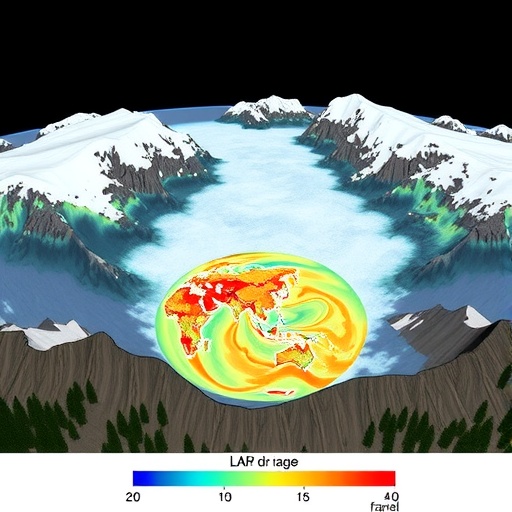The role of ice sheets in shaping regional climates has always intrigued scientists, and recent research efforts have focused on the prominent impact that the Patagonian Ice Sheet had during the Last Glacial Maximum (LGM). A comprehensive study conducted by Riquelme-Barraza, Gómez-Contreras, and Cosentino, and published in “Communications Earth & Environment,” shines new light on how this massive ice body influenced climate patterns in southern South America.
The Last Glacial Maximum, occurring approximately 26,500 years ago, represents a critical period in Earth’s climatic history, characterized by significantly lower temperatures and extensive ice coverage. During this time, the Patagonian Ice Sheet extended across vast territories, fundamentally altering regional weather systems and environmental dynamics. The findings of this study underscore the interactions between glaciation and climatic conditions, offering insights into past glacial periods that may help predict future climate trends.
Through state-of-the-art modeling techniques, the researchers reconstructed climate models that depicted temperature, precipitation patterns, and prevailing winds during the Last Glacial Maximum. These models revealed that the presence of the Patagonian Ice Sheet initiated a localized cooling effect, significantly impacting the atmospheric circulation patterns. This cooling effect had ramifications not only for Patagonia but also for broader regions influenced by the Southern Hemisphere weather systems.
The study meticulously analyzed sediment cores and ice core samples to assess climatic records over millennia. Through this analysis, the authors could correlate specific stratigraphic sequences with known global climatic events. Such correlations are crucial because they bolster the arguments for a significant ice sheet influence on the climate of the region, effectively illustrating the complex interplay between glaciation and climate changes during the LGM.
Additionally, the research highlights the role of orographic effects associated with the presence of large ice masses. The Patagonian Ice Sheet created barriers that modified wind patterns, leading to enhanced precipitation in some areas while causing aridity in others. The research provides compelling evidence that such changes created diverse ecological niches and influenced species distributions across southern South America, particularly concerning flora and fauna that adapted to these altered conditions.
Furthermore, the effects of the Patagonian Ice Sheet were not limited to just physical weather patterns; they also extended to biogeochemical cycles in the area. The massive ice sheet likely affected carbon cycling, with implications for the global carbon budget. During the LGM, colder conditions would have locked significant amounts of carbon in the form of organic matter in frozen ground, which changed how ecosystems functioned and how carbon was sequestered.
Importantly, the findings of this study have broader implications, particularly in understanding current and future climate scenarios. By analyzing how ice sheets interact with climate, researchers can develop more robust climate models that account for glacial components. This is especially critical in our current era, where global warming is prompting rapid ice melt and shifting weather patterns—a phenomenon with consequences that echo historical episodes like the Last Glacial Maximum.
In interpreting these changes, the study emphasizes the delicate balance between glacial forces and climatic outcomes, urging further examination of how similar processes may unfold in the regions currently affected by climate change. Early insights into these interactions may help in devising strategies for climate adaptation and mitigation.
The work conducted by Riquelme-Barraza and his colleagues not only advances our understanding of the Patagonian Ice Sheet but also serves as a clarion call for inter-disciplinary collaboration in climate sciences. Effective climate action requires integrating geological, biological, and atmospheric research to fully grasp the multifaceted influences on our planet’s climate system.
As scientists delve deeper into these intersections, the hope is that they might uncover predictive data that can inform policy-making and global climate strategies. Understanding historical climate shifts offers humanity lessons about resilience, adaptation, and navigation amidst a changing climate environment. This extensive study on the Patagonian Ice Sheet is thus more than just an exploration of the past; it is an essential piece of the puzzle that will shape future climate science and environmental stewardship.
Advancing this dialogue fosters a culture of curiosity and responsibility, where researchers, policymakers, and the global populace can work together to confront the challenges posed by climate change. The significance of past climatic events like the Last Glacial Maximum can no longer be relegated to academic discussions alone. Instead, they should serve as critical reference points as we understand our changing planet and seek ways to ensure a sustainable future.
As the discourse continues, one thing is evident: the intricate narratives woven within our planet’s climatic history hold the keys to navigating our future. With each study, we unweave complexities that could better prepare us for the impending challenges of climate dynamics.
Engagement with pioneering research such as this not only fosters a greater appreciation for the Pantagonian Ice Sheet’s historical significance but also furthers the discourse on global climatic influences. It reminds us that every piece of scientific knowledge contributes to a broader understanding of the world we inhabit and the future we strive to secure.
In conclusion, this groundbreaking research reinforces the vital connection between our current climate challenges and the historical precedents set by significant geological events. It invites all of us to reflect on our responsibility towards understanding and protecting our environment, nudging us closer to a communal approach to confronting climatic changes.
Subject of Research: The influence of the Patagonian Ice Sheet on regional climate during the Last Glacial Maximum.
Article Title: Patagonian Ice Sheet shaped regional climate during the Last Glacial Maximum.
Article References:
Riquelme-Barraza, F.M., Gómez-Contreras, Á., Cosentino, N.J. et al. Patagonian Ice Sheet shaped regional climate during the Last Glacial Maximum.
Commun Earth Environ 6, 798 (2025). https://doi.org/10.1038/s43247-025-02762-8
Image Credits: AI Generated
DOI:
Keywords: Patagonian Ice Sheet, Last Glacial Maximum, climate change, ice sheets, regional climate, environmental dynamics.




